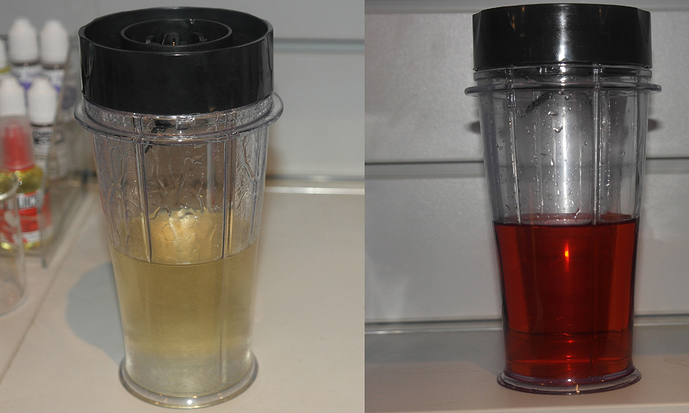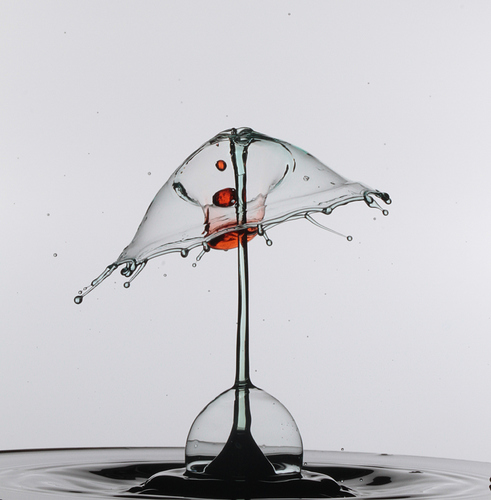Hidden science behind normal and accelerated e-Liquid steeping.
We are all aware that steeping an e-Liquid can improve its flavour and change its colour.
Here I am attempting to describe the cause and effect systems involved in steeping and accelerated steeping from a moderately scientific viewpoint.
There are two major processes involved in steeping e-Liquid
1. Removal of volatile components by evaporation and degasification
This process would include the removal of alcohol but is not restricted to alcohol, there are other volatile components used in the production of flavour concentrates that generally give off an astringent or chemical odour.
These process requires access to the atmosphere hence the need to remove tops from bottles
1a Evaporation – This is the same process as used in cooking to remove alcohol from wine.
1b Degasification – This is the same process as letting a fizzy drink go flat
Both of these processes are accelerated by heat and increased surface area.
This is a critical first step many e-Liquids are hideous and un-vapeable before this process.
Without acceleration this can take a week or longer due to the viscosity of the liquid.
2. The development of complex flavour molecules.
Over time some e-Liquids especially custard / caramel or desert flavours darken over time
From observation this cannot be oxidation as it occurs uniformly through the liquid and does not require agitation of the liquid to occur.
It also cannot be caramelization as this does not occur below 110°C.
Maillard Reaction - Colour and flavour
What seems to be happening is a Maillard reaction commonly experienced by most people every day. The browning of bread, toast and potato chips these are high temperature examples. Medium temperature examples creating Dulce de leche and condensed milk.
Mallard reactions also occur at lower temperatures and contribute to the aging of wine and Balsamic Vinegar.
Maillard reactions get exponentially slower as they progress
This fits in with our observations of steeping e-Liquid, a golden colour may be observed in a couple of days however the full desired flavour and colour may take 4-6 weeks to develop.
The Maillard reactions will continue to progress over time, hence those almost black bottles of e-Liquid that are found at the back of a draw.
The degree of colour change is dependent on the type of flavours present and the presence of Nicotine
Some flavours wont change at all these are often referred to as shake and vape liquids.
This mirrors the culinary world, you never see matured lemonade being sold.
Accelerating the steeping process
Removal of volatile components by evaporation and degasification
a) Taking the top off the bottle.
Evaporation and degasification simply wont happen with the lid on (Think bottle of lemonade)
b) Shaking the bottle (Helps)
c) Stirring (Helps)
d) Whisking (Very effective)
c) Blending to a foam (Super Effective)
d) Ultrasonic degasification (Super Effective)
Video showing ultrasonic degasification
http://www.hielscher.com/degassing_01.htm
d) Heating to 40°C-50°C (Accelerates all of the above methods)
Maillard Reaction - Colour and flavour
a) Heating to 40°C-50°C (Maillard reactions go slower at lower temperatures)
b) Ultrasonic treatment (local extremes of temperature and pressure act as a catalyst)
In Practice
The image on the left was taken immediately after mixing the image on the right was taken 5 Hours Later
60:40 VG PG 18% Nic 15% T-Juice Custard Concentrate
The e-Liquid was very vapeable the next day and is continuing to improve in the bottle.
Method used
a) Mixed liquid by weight directly into the blender cup.
b) Blended to a foam for 15 seconds remove lid
c) Placed into ultrasonic bath pre-heated to 50°C
d) 20 minute ultrasonic cycle
e) 20 minute rest
f) repeated (b) to (e) above six times
Then bottled into 50ml bottles
Storing after accelerated steeping.
Storing lid off in warm (room temp) draw or cupboard will allow any new volatiles to escape
This is less important as time passes.
The e-Liquid will continue its Maillard reaction gaining in richness, complexity and darkening
further.
There will be a point where you will not want the process to continue this is of personal preference.
This dictates how much you should make. As the Maillard reaction slows down most e-Liquids have a “Window of Niceness” lasting a couple of months.
The process can be slowed by refrigeration don’t freeze your liquid.
Quality and Issues
There is no quality related advantage accelerating the steeping of e-Liquid.
Some of the top note flavours may be lost through aggressive evaporation.
losing the freshness and crispness associated with fruit flavours is an example.
Heating some flavours may introduce an unwanted cooked flavour
If the acceleration process is overdone the “Window of Niceness” shelf life can be drastically reduced.
Full blown blending is impractical for quantities of less than about 100ml
Good old lid off in a dark place with a bit of a shake now and then will result in a perfectly steeped e-Liquid it is also far more predictable than accelerated steeping. It just takes longer.
As there are so many variables involved, you should always keep notes on how you
have steeped your e-Liquid****along with the ingredients. You can then easily replicate your successes.
The easiest way to do this is by using the http://e-liquid-recipes.com calculator and adding notes to your recipes
References
Wikipedia entry on Maillard reactions
Description of low temperature Maillard reactions
By
Joe Dyer 11/06/2015



 Good work! And thanks for sharing it!
Good work! And thanks for sharing it!